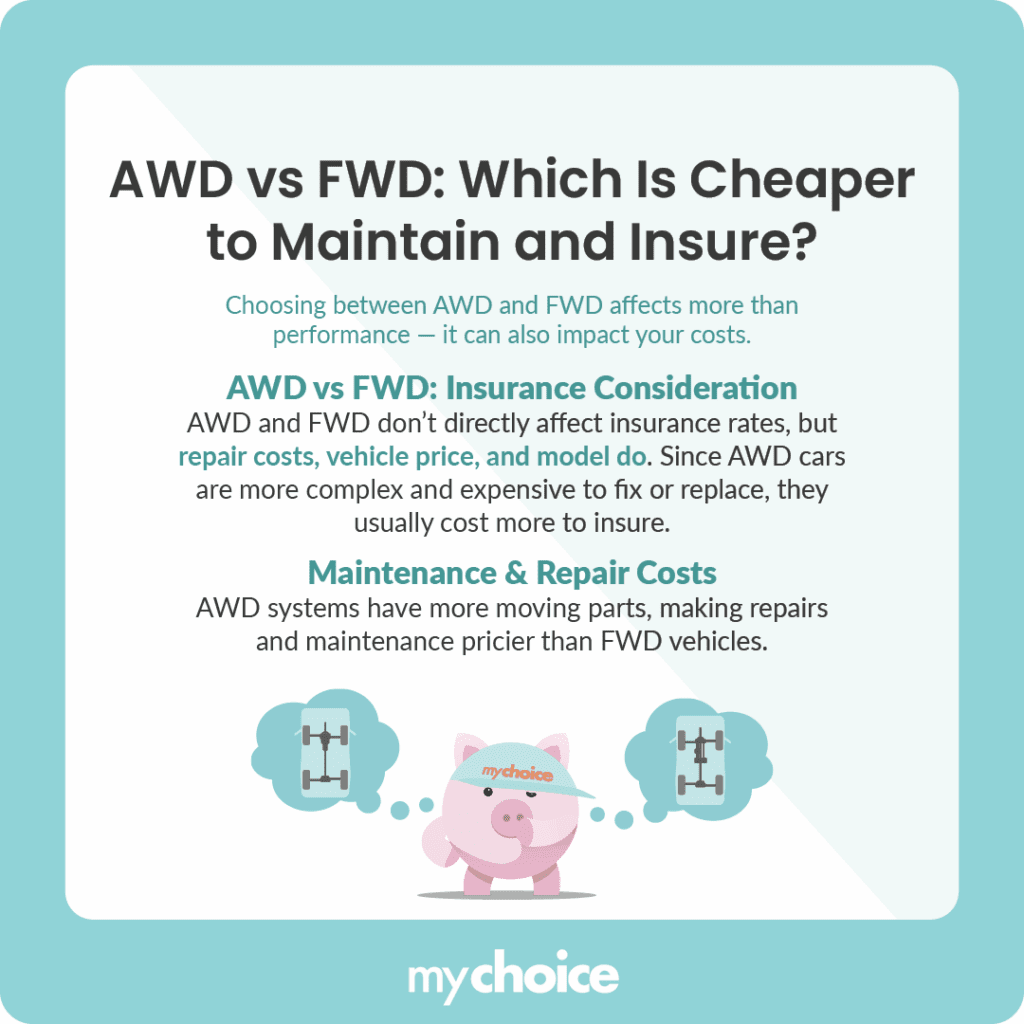When you’re looking for a new car, you might be presented with the choice of all-wheel drive (AWD) and front-wheel drive (FWD). This is a choice between a car’s drivetrain, which is what cars use to move. What does the choice of AWD vs FWD have to do with your car insurance? Keep reading to find out.
Does My Car Drivetrain Impact Auto Insurance Premiums?
The drivetrain choice itself doesn’t have a direct impact on auto insurance premiums. However, drivetrain choice does have an indirect influence since it’s usually related to your car’s make and model, safety features, year, and repair costs.
All-Wheel Drive vs Front-Wheel Drive: Key Differences
What are the differences between AWD and FWD cars? To make comparisons easier, we’ve created the table below:
| Feature | AWD | FWD |
|---|---|---|
| Purchase price | May struggle in deep snow or icy surfaces due to a lack of traction | Generally cheaper due to simpler design |
| Winter driving risk | Safer in heavy snowfall and heavy winter | May struggle in deep snow or icy surfaces due to lack of traction |
| Maintenance | Usually more expensive due to more components and higher complexity | Generally easier and cheaper maintenance due to fewer components |
| Resale value | Usually more expensive due to higher demand and better performance | Might not retain value as well as AWD, but cheaper upfront |
| Best for | Drivers willing to pay a premium for high performance and reliability in extreme weather | Drivers looking for affordable vehicles for daily commuting in mild weather |
AWD vs FWD: Insurance Consideration
The choice of AWD and FWD vehicles doesn’t affect your insurance premiums directly. However, it does have an indirect impact on your insurance through its repair costs, price, make and model, and other factors.
Generally speaking, AWD cars are more expensive to insure than FWD cars because when insurers set their rates, they calculate the cost of repairing or replacing the car. Since expensive cars are costlier to cover, that will be reflected in your premiums. You may also need more insurance if you have an expensive AWD car.
Maintenance & Repair Costs
As we’ve mentioned before, AWD cars are generally more expensive to insure due to their complex parts. That complexity usually also translates into higher maintenance and repair costs.

Driving Conditions Across Canada: In Which Regions Should You Have AWD Cars?
In most cases, you’ll be fine with FWD if your travels are limited to urban areas in large cities with relatively mild weather like Toronto and Vancouver, though you should still use winter tires when appropriate.
But if you live in snowy places like Montreal, Northern Ontario, and interior British Columbia, AWD cars are recommended to navigate the snow and ice that you’ll frequently encounter there. For extra snow protection, keep an eye on local winter driving rules, such as Montreal’s requirement for winter tires from December to March.
AWD vs FWD: Which One Do I Get?
There’s no strict requirement for you to get an AWD car anywhere in Canada. However, AWD cars may have an advantage over FWD cars in certain situations. Here are some key considerations to keep in mind when deciding between an AWD car and an FWD car.
Key Advice from MyChoice
- Choose an AWD vehicle if you want to be confident driving anywhere, including wet and snowy roads. Meanwhile, you should choose an FWD car if you just drive in urban areas with smooth, paved roads.
- Before choosing between an AWD and an FWD car, consider the insurance, repair, and maintenance costs.
- Pick an AWD car if you’re planning to resell, since it’s better at retaining value.








